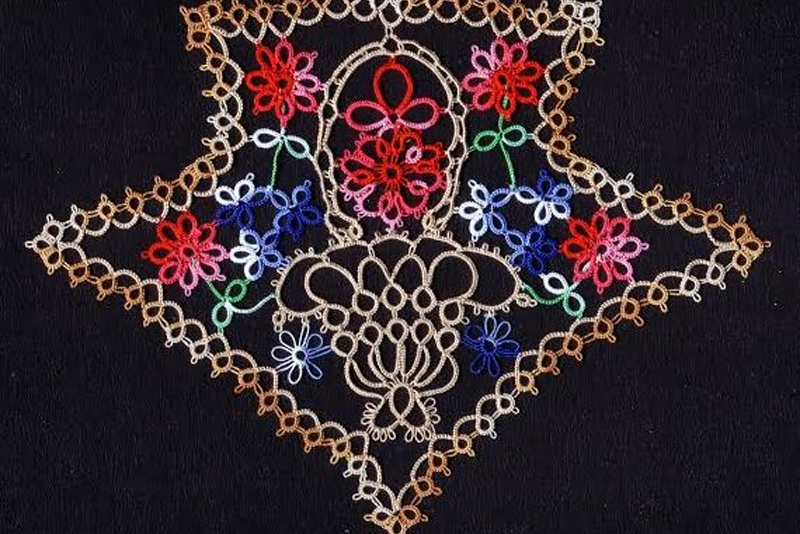Recently we studied a doily (remember the one that looked like a cut watermelon?) from the Endrucks book. I keep flipping through the pages and I have found another pattern to consider. Edging 11.

As edgings go, this is a little more complicated to tat and has lots of chains. It is a series of points separated by an individual set of chains/rings and the cross over chain is actually quite stretched. Please remember it is summer in my part of the world, so my imagination saw that separating set as two leaves on a stem and the main motif as a big garden beetle. But I was surprised to see, if you turned it upside down, a butterfly!!!.

It is harder to imagine it in the original lace photo, but take a look at the diagram!

Is it possible to tat this as a butterfly? Let's find out.
Using two shuttles or needle and ball thread begin at the base of the dotted line on the left of the diagram.
1. CH starter picot 1,
Cont CH * 4 - 6 dnrw
R 6 - 6 clr dnrw
CH 6 + (slj to picot adjacent) 4 + (join to starter picot)
CH 1
2. CH 4 + (slj to previous chain same spot) 6 (slj to ring) 6 dnrw
R 6 - 6 clr dnrw
CH 6 + (slj to previous chain) 6 + (slj to previous chain), 4 (slj to base of previous chain)
CH 1
3. CH 4 + (slj to previous chain same spot) 6 - 6 , + (slj to ring) 6 dnrw
R 6 - 6 clr dnrw
CH 6 + (slj to previous chain) 6 + (slj to previous chain), 6 (slj to previous chain) 4
CH 1
4. At this point the diagram and the actual tatted model do not agree. The diagram shows the large ring joined on both sides while the tatted sample shows that large ring joined in two spots on each side. Since we are trying for the butterfly here is my suggestion.
R 4 + (join to chain adjacent) 6 - 6 - 6 - 6 - 4 dnrw
The other side of the wing is a mirror image, so chains have the 1 ds between them, they all join at 4th ds and the other chain segments are all 6 ds, the rings at the top remain R 6 + 6.
To finish fashioning the body, after wing is done, tat one ring which will attach at the base of all the chains. RW. R 3 + 3 + 3 + 3 + (this join is made to the starter picot) 3 - 3 - 3 - 3 clr rw
CH 3 - 3 - 3 - 3 - 3.
Other adjustments might be...
a. add to the large inner ring a colorful bead in the center
b. add to the large inner ring beaded picots
c. add one very long picot after the ds that forms the starter picot, when finished cut it to form antennae
d. on the segments of 4 ds chains that start the wings, place iridescent bugle beads.

I would love to see your own variations. Enjoy.
Eleonore Endrucks-Leichtenstern, (German) Leipzig, Germany, Beyers Handarbeitsbücher 9, 1922 Free downloads are available: http://www.bellaonline.com/subjects/3137.asp http://www.georgiaseitz.com/public/eleonoreendrucks-leichtensternschiffchenspitzenbook1920.pdf http://www.georgiaseitz.com/public/endrucksinsertsdiagrams.pdf
http://www.bellaonline.com/articles/art28249.asp
Here's the latest article from the Tatting site at BellaOnline.com.
Alphabet A-K Anna Valeire Book 3 The Tatted Alphabet by Anna Valeire Book 3 pg. 15. Tatted initials are handy for many projects. And added flower or decorative picots are just fine, too.
http://www.bellaonline.com/articles/art304490.asp
Please visit tatting.bellaonline.com for even more great content about Tatting. To participate in free, fun online discussions, this site has a community forum all about Tatting located here -
http://forums.bellaonline.com/ubbthreads.php?ubb=postlist&Board=39
v I hope to hear from you sometime soon, either in the forum or in response to this email message. I thrive on your feedback! Have fun passing this message along to family and friends, because we all love free knowledge!
Georgia Seitz, Tatting Editor http://tatting.bellaonline.com One of hundreds of sites at BellaOnline.com







